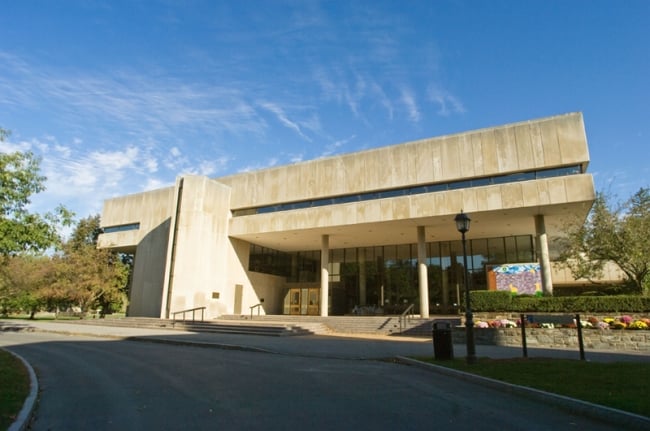You have /5 articles left.
Sign up for a free account or log in.

Hamilton College's Daniel Burke Library
Nancy Ford
Joan Hinde Stewart’s tenure as president of Hamilton College may be remembered as the time when the liberal arts college fully committed to a need-blind admissions policy. But in a recent meeting with Inside Higher Ed, Stewart stressed what she considered another of her top accomplishments: merging the library and information technology operations into one department.
Most colleges keep their libraries and IT departments separate, but at many smaller colleges -- and particularly liberal arts institutions -- administrators see a merger as a way to curb administrative costs. Others, however, see combining two departments with significantly overlapping responsibilities as the best way to serve their faculty members and students. Hamilton says it belongs to the latter group.
“With the impact of new technologies on the production and retrieval of knowledge, such a merger seems to me the way of the future,” Stewart said in a statement. “At Hamilton it was the result of extensive conversation and careful planning.”
That process dates back to Hamilton’s 2002 strategic plan, which proposed renovating and expanding the library. It was also aided by a series of coincidences may have made the merger less controversial than at other colleges, said David L. Smallen, vice president for libraries and information technology.
The college’s librarian, Randy Ericson, announced his intention to retire in 2011. Stewart then charged a Committee on the Library of the Future to chart the library’s path for the next decade. In its final report, the committee stopped short of endorsing a merger, but said the library should consider collaborating more closely with other departments on campus -- departments such as Information Technology Services (ITS), for example, which for decades had conveniently been located in the library and led by Smallen.
The merger became a reality two years later, as Hamilton announced the two departments would form the Library and Information Technology Services (LITS).
“We lived together for 40 years before we got married,” Smallen said. “There’s no substitute for people interacting with each other over the coffeepot. That was a real benefit.”
Broadly speaking, the new department’s mission is to teach students how to use information and technology to make well-informed decisions later in life, Smallen said -- in other words, preparing them “for the world in which they’re going to live.” The new department is also better positioned to support Hamilton’s growing Digital Humanities initiative and its consortium with three other liberal arts colleges to experiment with online education, among other projects that require both library and technology expertise, he said.
The merger has also improved the flow of communication, Smallen said. Hamilton, like the majority of colleges and universities, is doing its best to keep up with the changing scholarly publishing landscape. The college does much of that work through consortia, he said, and the merged structure ensures important news -- for example about electronic academic monographs -- reaches both librarians and IT staffers.
“It’s those kinds of moments where the problem being addressed has elements of both information and technology that this kind of organization really shines,” Smallen said.
Since the original departments were already located in the same building, much of the actual merger consisted of gradually bringing staffers with complementary job responsibilities together, Smallen said. Take Hamilton’s instructional technologists and research librarians, for example. Initially following the merger, they retained their titles but worked together in one group with two separate leaders. One year into that arrangement, the head instructional technologist retired, and the group renamed itself the research and instructional design team.
LITS is now an organization of about 60 people, with smaller departments dedicated to tasks as diverse as acquisitions, computer repair and jazz archiving. No staffers lost their jobs as a result of the merger, Smallen said. The college is instead using retirements -- there have been about four in total -- as “opportunities for further integration and rethinking.”
“If you merge the organizations, you should do it for strategic purposes, not to save money or just for efficiency,” Smallen said. Hamilton wasn’t trying to fix an “organizational problem” with the merger, he said, but to find the best way to support the college’s academic programs “in a world in which information and technology are changing in many different ways.”
Ann Campion Riley, president of the Association of College & Research Libraries, said mergers are typically seen as a way to cut costs, since the college only needs to pay one dean or director. Mergers often become controversial for that reason. Indeed, at some liberal arts colleges, library directors have resigned in protest or been fired after disagreements about the future of the library. The role of technology has been a central topic in several of those cases.
Colleges may also be attracted to the “synergies” between libraries and IT departments, Riley said. When it comes to teaching students about information literacy, for example, the two departments can make for good partners, she said.
The reason mergers are popular at liberal arts colleges is simple, Riley said: the departments are smaller, meaning a merger doesn't create a “big, unwieldy organization.”
Still, mergers at liberal arts colleges haven't always been successful. Gettysburg College considers itself one of the first liberal arts college to attempt one. The college moved its IT staffers into the library in February 1994, creating a new department it dubbed Information Resources.
“It was hoped that a merger would meet critical technology goals, consolidate resources and eliminate redundancy,” Jamie Yates, the college’s director of communications and media relations, said in an email. “In these areas the merger was successful.”
Information Resources only lasted for three and a half years, brought down by factors such as cramped accommodations, opposition from faculty members and an “unwieldy and unworkable” team structure. The initiative also lacked a “grassroots planning process,” Yates wrote.
Smallen said he recommends colleges at least consider a merger, even though the timing may not be right on every campus.
“Organizations are what they are,” he said. “You can’t really force these issues.”







